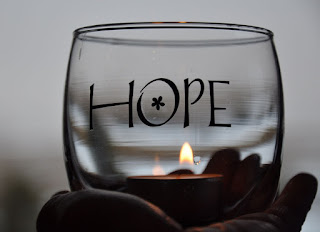The Season of Hope
With
the arrival of winter, just on the heels of autumn, comes an aromatic fragrance
of hope. Hope fills the air of bone-weary people who are looking forward to a
time of rest and rejuvenation with friends and family, as an escape from the
busyness of demanding schedules. Hope wafts through poverty-stricken
neighborhoods of single parents whose greatest dream is to see their children
thrive and reach their full God-given potential in a world where their
potential is often stifled and truncated. In the streets and barrios of
middle-class America, where inequities and injustices rear their unwelcoming
faces, there is an unwavering hope for justice, a lingering hope that primarily
people of color are seeking, and when found, will hold it in a clinched fist,
with the hope of not letting it go.
The anticipation of hope is as prevalent
today as it was in 1899 when James Weldon Johnson penned the poem “Lift Every Voice and Sing.” This poem-turned
song, the National Anthem for Black America, a beacon of hope for which we
proudly stand, is at once an invitation to cry out in unison and fierce
determination until liberty is achieved. It is an invitation for marginalized
people of color to hope without ceasing and to rejoice in anticipation of the
pending year of jubilee, where all the debts of injustices are cancelled. It is
an invitation to march unfailingly until victory is won.
This song is an invitation to hope. The
words inspire hope. Within the first stanza, there is an invitation to sing a
song full of the hope that the present has brought us. It is a song of a
spiritually and deeply faith-filled people, whose reliance on the God of hope
enables them to believe that there is something greater on the horizon. For a
people who have experienced injustice and inequities, this sense of hope in the
present is the fulfillment of faith. In the New Testament, the writer of
Hebrews says,” Now faith is the assurance of things hoped for, the conviction
of things not seen.” (11:1, New Revised Standard Version) Hope then becomes the
catalyst by which our faith in God takes on a new shape and gives us strength
even when it seems that there is little to hope for.
Within the second stanza, Johnson writes
these words: stony the road we trod, bitter the chast’ning rod, felt in the
days when hope unborn had died. This claim is powerful. To suggest that hope is
unborn, unrealized, and has died could easily derail our faith. However,
because our hope is built on nothing less than Jesus’s blood and righteousness,
then we are able to see the birth of hope in the assurance of what we know God
will do. Hope is within reach. Hope is available. Hope is an integral part of
our Christian faith and it is a reminder that our ancestors, those who toiled
and tread in places that are unimaginable, knew that their efforts would
produce the kind of hope that the present has brought us. Hope in the form of
access to resources. Hope in the privilege to use our voices in the right to
vote. Hope in seeing people of color in decision-making positions in major
companies, corporations, government and educational institutions.
It is the audacity to hope that as
Christians everywhere prepare to celebrate the arrival of the Christ child –
whose very birth is the assurance and evidence of the hoped-for Messiah, that
we are closer to dismantling and removing the barriers that stand in opposition
to hope. This season is all about the birth of hope that this world so
desperately needs. Hope is our motivation to keep pressing forth. Hope is the
prescription for the days when we feel like giving up and giving in. Hope is
the metronome that steadies us and keeps us in rhythm when we are fraught with
the predictable challenges that are sure to come our way.
This season, let our hope be renewed and
restored. Our ancestors are cheering us on, and the generations that will come
after us are counting on it and hoping
for it.
~Yvette R. Blair-Lavallais * copyright 2017


Comments
Post a Comment